Mercury In Your Pet Food
Dr. Sarrah Dunham-Cheatham
 Postdoctoral Scholar Dr. Sarrah Dunham-Cheatham randomly sampled 100 pet foods searching for mercury. Sixteen of those samples had mercury concentrations that were well above the maximum tolerable limit. That's not the only thing she found.
Postdoctoral Scholar Dr. Sarrah Dunham-Cheatham randomly sampled 100 pet foods searching for mercury. Sixteen of those samples had mercury concentrations that were well above the maximum tolerable limit. That's not the only thing she found.
Researchers at the University of Nevada in Reno have been pondering the question, "What is really in the food our pets eat?" So they started looking for answers. The results of their first study are worrisome. In the first 100 samples they analyzed, 16 of those samples had mercury concentrations that were well above the maximum tolerable limit. Most of those high mercury levels were found in fish-based cat foods, mainly tuna cat food, but the high mercury levels also showed up in products with salmon, white fish and shrimp. And it's not only cat food. They found high mercury levels in dog food too. These included both wet and dry foods.
Dr. Dunham-Cheatham lead the study and tells us her team selected the foods by basically going to the store and identifying the more commonly purchased brands. They started at the lower end with brands from Wal-Mart and Costco. Then they looked at the medium and high range brands as well. They tried to get an even distribution between dog and cat food and dry and wet foods as well. They all have pets and some of the items were even donated from their own houses. Other foods were donated from their friends and family as well. But most of them were randomly purchased straight from the shelves.
For the study that is currently out there with data, they basically looked for the total mercury concentrations in all of those foods. They weren't looking at the different types of mercury; just how much was in there. They found that of the 101 samples that they tested, that 16 of those samples actually had mercury concentrations above the maximum tolerable limit set by the FDA for pets.
So does this mean somebody has violated FDA regulations? Dr. Dunham-Cheatham says absolutely not, because the FDA doesn't have regulations for mercury in pet foods. They have limits and say animals should not be consume more than certain amounts, as it would be a health hazard. However, there's no standard that the FDA can legally hold the pet food manufacturers accountable for it in their foods. So there could be lethal limits or there could be absolutely none, and it's legal. This is one of the things that they really wanted to test because the FDA is not overseeing this nor are the pet food manufacturers overseeing this. So what does the baseline look like for people and for their pets? We're feeding our pets meal after meal and day after day and month after month, probably the same food, most of their life.
 High levels of mercury were found mostly in tuna or fish related foods. Of 100 foods that they tested, all of the top offenders, the ones that were all above the maximum contamination or tolerable levels, were tuna based or fish based. This is not surprising, as humans have an advisory level regarding fish. As adults, we're not supposed to eat more than two cans of tuna per month because of the mercury concern. And that should hold true for pets as well. There's a whole literature out there of fish + mercury = bad. So it wasn't a concern to them that tuna based pet foods had the highest mercury concentration. However, it does show a little bit of worry for us as consumers and pet food owners if we're feeding our pets tuna based or fish based foods routinely.
High levels of mercury were found mostly in tuna or fish related foods. Of 100 foods that they tested, all of the top offenders, the ones that were all above the maximum contamination or tolerable levels, were tuna based or fish based. This is not surprising, as humans have an advisory level regarding fish. As adults, we're not supposed to eat more than two cans of tuna per month because of the mercury concern. And that should hold true for pets as well. There's a whole literature out there of fish + mercury = bad. So it wasn't a concern to them that tuna based pet foods had the highest mercury concentration. However, it does show a little bit of worry for us as consumers and pet food owners if we're feeding our pets tuna based or fish based foods routinely.
This affects mostly cats. This can even be more of a concern, because cats are actually more sensitive to mercury than most other species, like dogs. And you're probably feeding them about 2 cans of wet food per day. And if you were only feeding them tuna, that adds up to a lot of mercury in one month.
Is there any correlation between mercury and certain ailments in our pets? Dr. Debbie tells us one of the big concerns is multisystemic. There can be neurologic disorders as well as digestive problems. In humans, the concern is with pregnant women and the developmental status of altering an abnormal development of a fetus. So that's a big concern that we really don't look at with cats and dogs as well.
So what should we do? Is it mostly up to regulation now? Dr. Sarrah Dunham-Cheatham says that previously, the house actually voted to deregulate the regulation that they have currently for pet foods. So a lot of the standards put in regulations at the time of the 2007 pet food epidemic, we're just actually removed. Now, the FDA has even less authority over what pet food manufacturers are creating. So as a pet food consumer and pet owner, she thinks the concern and the action should be to really pay attention to what's in your pet food. Read the labels suspiciously or at least consider where those ingredients might be coming from and back off the fish.
There were actually two components of their current research project. One is looking at total mercury and methyl mercury, which is an organic form of mercury that's extremely toxic for all forms of life. But the second portion is also looking at the DNA composition of food. They did a very quick preliminary test of a couple of different pet foods just to see if it was worthwhile to pursue this project. Basically they tested a well-known, common brand of pet food labeled 'Duck and Potato.' They found that there was duck in the food, so that was not a concern. However, they also found that there was sheep in the food and there was no sheep mentioned on the label. They do know that some of these manufacturers are using products that are not identified on a package ingredient list, which for animals that maybe have allergies or sensitivities with certain products, this can be a concern for their health. They were also looking at the DNA composition of the food that they will be analyzing for mercury to see if the ingredients are accurate or not.
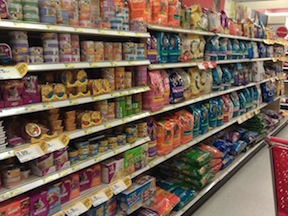 Just think of people that have allergies to different food products. What if you were allergic to peanuts or shellfish and your food wasn't labeled properly? If we look at animals' health in the same way, we really ought to have some significant standards to say what is in there, is actually in there. This makes this research really important.
Just think of people that have allergies to different food products. What if you were allergic to peanuts or shellfish and your food wasn't labeled properly? If we look at animals' health in the same way, we really ought to have some significant standards to say what is in there, is actually in there. This makes this research really important.
Dr. Dunham-Cheatham tells us that they crowd-funded this research project, as they didn't want any money from pet food manufacturers or big donors.
Visit Website
The Raw Debate
Chef Kevyn Matthews
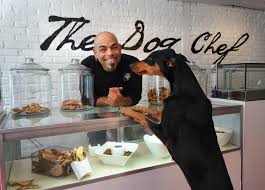 Chef Kevyn Matthews, also known as the Dog Chef (Dogs 101/DOG-TV) is doing a booming business cooking for dogs. He makes nutritious meals that focus on healing certain ailments. Here, he debates the pros and cons of a raw diet with Dr. Debbie.
Chef Kevyn Matthews, also known as the Dog Chef (Dogs 101/DOG-TV) is doing a booming business cooking for dogs. He makes nutritious meals that focus on healing certain ailments. Here, he debates the pros and cons of a raw diet with Dr. Debbie.
Chef Kevyn Matthews is not only "The Dog Chef" on DOG-TV; he also owns an award-winning dog cafe in historic Mt. Vernon, Baltimore, which is the first of its kind in the city. The Dog Chef Cafe serves fresh food, fresh treats and fresh frozen yogurt. They also make custom meal plans as well. They also host dog parties. It's an awesome place to be according to Chef Kevyn.
You won't find any human food at the cafe; it's all dog stuff. However, it is all human grade and looks human edible and humans can actually eat it. But if humans want a bite of something to eat, there is a cookie shop a couple doors down from the shop. Chef Kevyn said he didn't want to compete and if the other shop started making dog treats, it would ruin the neighborhood. So Chef Kevyn sticks to dog treats and the other shop sticks to the human treats.
Business at the cafe is excellent and they are growing so large in Baltimore that the Baltimore Orioles called Chef Kevyn so he could cater their Bark In The Park event at the stadium. He's done that twice now. For the event, he made little hot dog cookies and pretzels as well as frozen yogurt. Everyone loved it. They even put the frozen yogurt in little plastic baseball hats that the park normally serves human ice cream out of. Chef Kevyn said it was such a cute event. Can you imagine, bringing your dog to the park and watching the game with your dog - so amazing!
From a young age, Chef Kevyn knew he wanted to be a cook. He tells us that it was probably in the first grade when he drew a picture of snoopy with a chef's hat on that said, "Cook" above it.
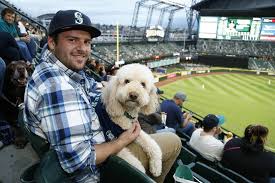 Growing up, Chef Kevyn was always obsessed with the nutrition of the dogs that he had. As an adult, he got into the culinary field. He then switched over to making dog food after he got this awesome dog when he lived in New York by the name of Greta. He just wanted the best for her so he started making all of her food. Actually, he started doing it because she refused to eat. She refused to eat anything that he brought home. The last time that he went back to the pet store, he was listening to the radio and heard about all of the dog food recalls that were happening. It turns out what he was trying to give her, and what she was turning away, was some of this recalled food. That's what snapped him into cooking for her.
Growing up, Chef Kevyn was always obsessed with the nutrition of the dogs that he had. As an adult, he got into the culinary field. He then switched over to making dog food after he got this awesome dog when he lived in New York by the name of Greta. He just wanted the best for her so he started making all of her food. Actually, he started doing it because she refused to eat. She refused to eat anything that he brought home. The last time that he went back to the pet store, he was listening to the radio and heard about all of the dog food recalls that were happening. It turns out what he was trying to give her, and what she was turning away, was some of this recalled food. That's what snapped him into cooking for her.
Chef Kevyn believes in a raw food raw diet. He says you have to look at how a dog digests food as opposed to how a human does. Look at what is in that bag of processed dog food and how it's made and how it reacts to the system inside of a dog.
How many wolves do you know that cook their food? When they do eat food, it's fresh. It's a source that they know. They're personally attacking the food and it's just that fresh. It's not dry. It's not abrasive. It doesn't have any chemicals or additives to keep it fresh on a shelf for 10 to 12 months. If a wolf sees a dead animal that's been outside for 10 months, he is not going anywhere near it. However, we have trained our dogs to eat this type of food. The way they do that, because this food normally wouldn't be attractive to a dog, is they put all these things in it that smell attractive. For instance, liver when you're using beef. But, it's not like your feeding it real beef or a little bit of liver. Keep in mind that you don't want to feed too much liver, because it's kind of harsh.
Dogs aren't even supposed to be chewing food, according to Chef Kevyn. He thinks it's funny how people say, "Oh, my dog doesn't chew, he just swallows." Then think about the wolf again. A wolf bites and pulls his food and then throws it in the back of his throat or his esophagus and it just goes down. That's normal. You can't do that with kibble. If you take a piece of kibble and you rub it against your skin, it starts to hurt after a while. Imagine what that does to the inner organs of a dog.
 Dr. Debbie explains that when you compare wolves with dogs, one of the adaptations that dogs have had over the years is a process called domestication. And so today's dogs are domesticated and have learned to live closely with humans, so their digestive tracts have actually adapted and changed and altered. They are not necessarily the same as what you would find in a wild canine out there, because they have made their life kind of sneaking food, living close to people and getting what we have. However, it's not to say that the process of domestication is wrong and it's led to bad behaviors. Dogs have learned to adapt to what we eat and we just always assume nowadays that they should eat the same things we do. She thinks that we just have to step back a little bit from that and analyze it, because we're not telling people to feed their current pets like a wild wolf. Obviously we don't want them tearing carcasses up and things like that. So whatever works for the convenience, the nutrition and the wellbeing of the animal is important.
Dr. Debbie explains that when you compare wolves with dogs, one of the adaptations that dogs have had over the years is a process called domestication. And so today's dogs are domesticated and have learned to live closely with humans, so their digestive tracts have actually adapted and changed and altered. They are not necessarily the same as what you would find in a wild canine out there, because they have made their life kind of sneaking food, living close to people and getting what we have. However, it's not to say that the process of domestication is wrong and it's led to bad behaviors. Dogs have learned to adapt to what we eat and we just always assume nowadays that they should eat the same things we do. She thinks that we just have to step back a little bit from that and analyze it, because we're not telling people to feed their current pets like a wild wolf. Obviously we don't want them tearing carcasses up and things like that. So whatever works for the convenience, the nutrition and the wellbeing of the animal is important.
Dr. Debbie is not a fan of a raw food diet for our dogs, as she's treated the negative sides of it. She tells us the downsides are the foodborne illnesses of the individual dogs and cats that she's had to treat. Then there are the bones along with things like that. She says it can be done well and she knows clients that have done it. However, personally she's not a fan of it because she's had to treat the bad stuff. Dr. Debbie also explains that she even doesn't cook for herself!
She also tells us that there are a lot of the same bad things that are happening in human foods too. Herbicides are showing up in animal food products. They're are also in human foods. So this isn't just necessarily an animal food problem, it's also a human nutritional problem and we really have to look at where we're sourcing our foods.
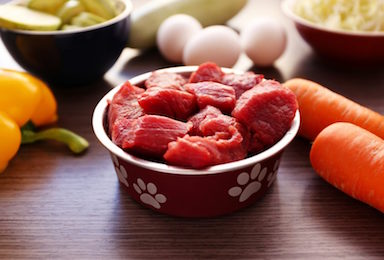 Chef Kevyn agrees that there needs to be better options across the board, because like Dr. Debbie said, there are people like her that don't agree with a raw diet probably because she's had bad experiences or because people do it the wrong way. The majority of Americans don't make their dog food; so we need to start making these companies that are making millions and millions of dollars a year, take responsibility.
Chef Kevyn agrees that there needs to be better options across the board, because like Dr. Debbie said, there are people like her that don't agree with a raw diet probably because she's had bad experiences or because people do it the wrong way. The majority of Americans don't make their dog food; so we need to start making these companies that are making millions and millions of dollars a year, take responsibility.
If you want to cook for your pet but don't really have a lot of time, Chef Kevyn says he's here for you. While it's not cheap to have your pet food prepared and shipped to you by Chef Kevyn, if you weigh it against what you would be paying for bet vet bills, it's worth every cent.
Visit Website
Don't Stuff Your Pet With Thanksgiving Leftovers - Dr. Debbie
 Thanksgiving is all about enjoying time together - family, friends and great food. In many households the family pet may also sample a taste from the holiday table; a morsel of turkey breast for Tabby or a side of fixings for Fido. Tuned in to those enticing smells, our pets know how to manipulate us with a flutter of sad puppy dog eyes or incessant meowing.
Thanksgiving is all about enjoying time together - family, friends and great food. In many households the family pet may also sample a taste from the holiday table; a morsel of turkey breast for Tabby or a side of fixings for Fido. Tuned in to those enticing smells, our pets know how to manipulate us with a flutter of sad puppy dog eyes or incessant meowing.
Sharing these Thanksgiving goodies with our pets can put their health in jeopardy, but many of us do it. Over 60-percent of pet owners confess to sharing their holiday meal with their pets, but that doesn't make it wise.
Here's Why
Dogs' and cats' digestive systems thrive on a stable, consistent diet. Toss in a few leftovers and your pet will respond with a thankful tail wag, but it could leave him with gastroenteritis and leave you with vomit and diarrhea messes sprinkled about the house.
Sharing Thanksgiving leftovers can risk more than just an upset belly though. Feeding human food to our pets can trigger pancreatitis, an inflammation of the pancreas that results in release of digestive enzymes into the abdomen. Pets with pancreatitis develop vomiting, diarrhea, lack of appetite and abdominal pain, often demonstrated by a hunched abdomen. Pancreatitis is painful and life-threatening and may result in bleeding disorders or heart arrhythmias. Treatment for pancreatitis includes hospitalization, intravenous fluids, pain medications and anti-nausea medications.
Pancreatitis risk is greatest in obese pets or those that ingest especially fatty foods like greasy meat trimmings, sauces and other rich side dishes. Be especially cautious with Schnauzers, who have an increased risk of pancreatitis due to breed predisposition.
Thinking of handing that turkey bone to your dog? Fugettaboutit! Any bones even cooked bones have the potential to splinter, damage the digestive tract, or cause an intestinal obstruction. Bone chewing also leads to damaged, chipped teeth, which may require root canal surgery or surgical removal. You are better off to just brush those pearly whites than risk tooth pain and a costly dental procedure.
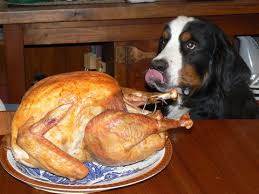 If you are looking for a safer way to include your pets in the holiday cheer, have a handful of pet treats on the ready. Better to stick with snacks you are certain will agree with your pet's digestive system. But if you must look on the table for your pet's treat, offer a small amount of white turkey meat without the skin or bones. Skip the sides, sauces and deserts. And be wary foods that are toxic to pets such as raisins, grapes, onions, macadamia nuts and chocolate.
If you are looking for a safer way to include your pets in the holiday cheer, have a handful of pet treats on the ready. Better to stick with snacks you are certain will agree with your pet's digestive system. But if you must look on the table for your pet's treat, offer a small amount of white turkey meat without the skin or bones. Skip the sides, sauces and deserts. And be wary foods that are toxic to pets such as raisins, grapes, onions, macadamia nuts and chocolate.
After the meal is done, do a thorough cleanup and discard the turkey bones in a secure, outdoor garbage can away from pet access. Store leftovers in the refrigerator or where pets cannot reach them. Keep on the watch for the curious pets with a nose for trouble. Pets will ingest the turkey string, foils and any items with juices dripped on them.
Being thankful for your pets doesn't mean you have to stuff them with leftovers. Veterinary clinics across the country see a surge in sick pets every year after Thanksgiving. Be informed about Thanksgiving dangers and you'll avoid that unwanted emergency room visit this holiday.
Featured veterinarian known as "Dr. Debbie" on national pet radio program, Animal Radio. Ebook author of "Yorkshire Terriers: How to Be Your Dog's Best Friend"; "Pugs: How to Be Your Dog's Best Friend"; "Mini Schnauzers: How to Be Your Dog's Best Friend"; and "Shih Tzu: How to Be Your Dog's Best Friend." Dr. Debbie's books.
Visit Website
 The Dogfather's Grooming Tip with Joey Villani
The Dogfather's Grooming Tip with Joey Villani
If You Can't Afford A Groomer - There Are Alternatives
If you can't afford a groomer, don't neglect your pet's coat. Over time, a neglected coat can become so matted, your dog might have to be shaved. A matted coat can also lead to sores and infections. In addition, certain types of dogs such as Poodles and Yorkshire Terriers that have facial hair that can easily become overgrown. Without regular care, this hair can make it difficult for your pet to eat and may even affect their vision.
Before doing anything else, first check with your local groomer, as the cost may not be as high as you think. However, if you are on a fixed budget, or for whatever reason you can't afford having your pet groomed, there are alternatives.
Joey explains that one such alternative is a vocational-technical school, often called a vo-tech school, which are high schools in the United States and Canada designed to bring vocational and technical training to its students. There, you might find someone who is learning how to be a groomer. If so, there will also be a qualified instructor overseeing the grooming session, who probably will do 90-percent of the grooming, so you know it is being done right. They are also a lot more inexpensive than taking your pet to an established groomer.
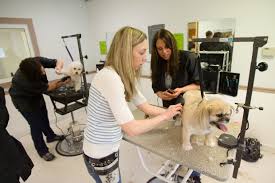 Another such alternative is actually a grooming salon. Many salon owners are becoming licensed to train groomers. They will then be looking for pets for their students to work on. And again, they will oversee the session so you know it's being done right.
Another such alternative is actually a grooming salon. Many salon owners are becoming licensed to train groomers. They will then be looking for pets for their students to work on. And again, they will oversee the session so you know it's being done right.
It's important to have your pet groomed on a regular basis so if you can't afford to take them to a groomer regularly, check out all of the possible alternatives.
Animal Radio News - Lori Brooks
 Tesla Offering Unique Dog Friendly Features
Tesla Offering Unique Dog Friendly Features
Tesla cars can be expensive, but a feature aimed at pet parents might make it more than worth it. One of Tesla's new car features includes a computer program that stops the car's interior from exceeding a certain temperature. A future update to it may include a special 'Dog Mode,' which would display a message warning passers-by not to panic if they see a pet inside a parked vehicle. That future update could also include a display of the current interior temperature so well-meaning strangers don't break the car's window to rescue your pup. The temperature-regulating feature is called Cabin Overheat. It was rolled out to Tesla vehicles via a software update in June. When the car is parked, Cabin Overheat ensures that the temperature inside the car doesn't exceed a preset limit. It's meant for safety rather than convenience, so your pet will be safe if you accidentally leave it in the back seat for a few minutes. The company stresses, however, that it is not for keeping them comfortable over long periods. To be clear, the ASPCA advises never leaving a dog alone in a parked car and notes that doing so is illegal in some states.
When Are Puppies The Cutest?
Everyone knows puppies are cute, but did you know that people find puppies at their cutest stage at eight weeks of age? Experts at Arizona State University's canine-science laboratory now say they have discovered that peak puppy cuteness serves important purposes and might even play a fundamental role in the bonding between a puppy and its adoptive owner. In recent a study, researchers at the university sought to pin down, scientifically, the timeline of puppy cuteness. People consistently rated dogs most attractive when they were six to eight weeks old. This age coincides with a crucial developmental milestone. Mother dogs stop nursing their young around the eighth week, after which pups rely on humans for survival. Peak cuteness, then, is no accident. It is at the exact moment when human intervention matters most, that puppies become irresistible to us. It doesn't hurt that humans seem to be especially vulnerable to cute things. Research dating back to the 1940s shows that virtually any creature with baby-like features such as large eyes, a bulging forehead and short limbs, is capable of drawing our affection.
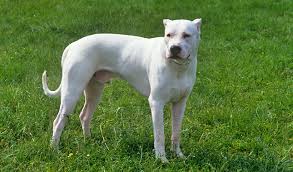
 Two New Breeds Added to National Dog Show
Two New Breeds Added to National Dog Show
The National Dog Show, which airs every year on Thanksgiving Day on NBC, has announced that two new breeds will be added to the competition this year. One of those to be added is the Barbet (Sporting Group), which has a curly coat and be black, brown, gray or fawn colored, sometimes with white markings. The second breed is the Dogo Argentino (Working Group), with short white coats. A dark patch is permitted near the eye, as long as it doesn't cover too much for the head.
Stop the Fake Service Animals!
Many transportation providers of all kinds are getting fed up with passengers trying to pass off as their pet as a "service animal." Previously in Colorado, a passenger boarded a bus with a boa constrictor wrapped around his neck. Another passenger had a tarantula in his hands, while another carried a ferret. Now, the Denver Rapid Transit District, or RTD, is getting fired up. The agency's manager has issued a statement. The message is: STOP! The RTD points out that those animals do not qualify as service animals because they cannot be trained to perform a service or task that their owner or handler cannot perform for themselves. Federal regulations state that service animal means only dogs and mini-horses can be used as legitimate service animals. Many people whose lives depend on a service animal say the fake service animals make it more difficult for those who genuinely need them.
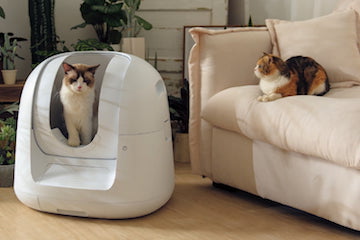 Kickstarter Cat Potty
Kickstarter Cat Potty
Once in a while a Kickstarter project comes along that captures the peoples' attention in such a way that it rakes in close to 10 times its funding goal within just a few days. This is one of those. It's a futuristic looking cat potty called Footloose that promises to be the most cutting-edge way imaginable for your kitty to cleanly go potty. It cleans itself automatically and monitors the wellness of the feline user. The patent-pending, self-cleaning mechanism can distinguish between litter and your cat. It can even recognize multiple cats and tell you each cat's body weight, waste volume, toilet frequency and duration. It also comes with an integrated deodorizing unit.
 Listen to the entire Podcast of this show (#1094)
Listen to the entire Podcast of this show (#1094)





